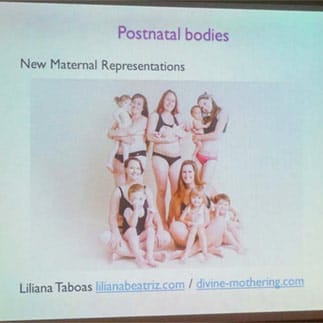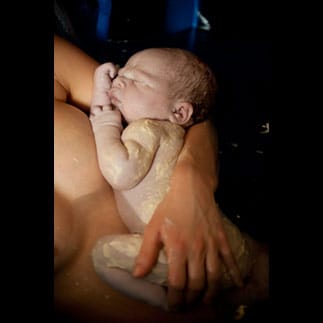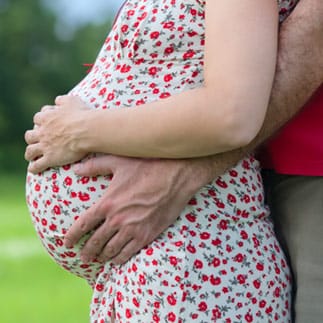Postnatal Bodies
Maternal representations, body images, and mothers’ real life experience.
Birthlight Womb to World 2015
At the 2015 Birthlight Womb to World conference I spoke about postnatal bodies and the disparity between what the media says and women’s real life experience. When this conference theme was first announced publicly, I felt compelled to make a contribution based on the work that I’ve done with mothers moving through the transition to parenthood, with special emphasis on the postnatal period. In addition, concerns around Maternal Representations were a powerful influence during my days as a postgraduate student in Women’s Studies, researching women’s accounts of childbirth for my PhD. The synthesis of these two significant areas of my life inspired my presentation that I’ve adapted as a blog.
My background
I became a certified childbirth educator and doula back in 1978, and taught birth preparation classes for 20 years. My background in psychology prompted me to create postnatal groups for new mothers that explored the psychological changes that parenthood brings, and after several years of facilitating groups, I took the most important elements of what women were looking for and created a postnatal exercise class for mothers and babies that was unique at the time (early 1980s), called Reshape & Unwind. Mothers wanted to get back into shape and find meaningful ways of playing with their babies. The class offered a workout for the mother and then we turned our attention to the babies and exercised them, and mothers were taught how to massage their babies too. However, the class was much more than just an exercise class for new mothers and babies.
Back in 1997 I received a letter from one of my clients that said: “you have created an incredibly nurturing environment in the guise of an ‘exercise class’ that I wish I could keep coming [to] until all my children are grown! I signed up for your class feeling isolated and nervous as a new mother… I went back to work six months later, having spent five of those months in your house twice a week, a much more confident and toned up new mother! Your class was like a sanctuary…a mirage of a waterfall in the desert of new motherhood… I simply cannot say how strongly I feel about the support you gave to all of us in the class.” The class gave them structure for their week, a safe haven, and created old-fashioned networks of mothers who remained friends for decades. When I immigrated to the UK, I continued to teach this class for about a year, first through a leisure centre and then privately using a church hall. My understanding of postnatal bodies is grounded in this experience as a perinatal fitness instructor for 20 years.
Postgraduate studies and feminism
I received my Master’s Degree in the Psychology of Parenthood, and while I was studying at New York University I attended several feminist courses which inspired me to pursue my PhD using my case notes as an allied health professional as the data for analysis. As a women’s reproductive health activist and educator, feminist theory deepened my awareness of women’s oppression and disempowerment. Childbirth had been a neglected part of the feminist agenda, considered too essentialist, or biologically determined, for the comfort of most feminists then. I like to think that my thesis put childbirth back on center stage as a feminist site for women’s reproductive health.

Maternal Representations and Images reflect the societies in which they are produced, and the values those societies hold for motherhood. Representations of Motherhood, with its provocative cover image from the 1940s, was a book that informed part of my PhD. And what a powerful image this is of the dominated mother and towering baby. Whereas childbirth was resisted as a subject of study, motherhood was the object of significant attention by feminism, re-examined in every discipline, many included in this edited collection of essays. The second wave of feminism was seen as a response to the postwar period, the time when this cover image originated.
The volume tackles some of the social myths that permeate and complicate the lived experience of mothering in a way that acknowledges the mother’s subjectivity and her ability to reflect on and speak of her experience in changing those myths and altering her social reality. It’s not just the cultural myths that reverberate within these representations, but also the multifaceted nature of our own maternal bonds that echo through our emergent sense of self. Maternal images have a primal pull, triggering our earliest and most primitive experiences, our unconscious associations of being mothered.
Transition to Parenthood
The transition to parenthood can be a fraught time when parents are navigating massive changes on so many levels including a new or expanded identity, new roles, relationship challenges, high expectations and a whole new life experience with a very dependent little person. It all happens at a time when the parents are themselves in a heightened state of vulnerability. The baby, and the intense responsibility that goes with it, does loom large for new parents, and many of the aspects that were true in the 1940s are still current for many parents. What’s changed is the number of opportunities that are available to women in the 21st century, thanks to the women’s movements internationally. But there’s a common experience for new mothers that happens after birth, when all eyes turn to the baby, and the new mother becomes virtually invisible. Throughout her pregnancy she was the center of attention, glorified and pampered through the whole range of pregnancy activities that culminate on the day the baby is born. Then she seems to fade from view, dropping into the background as the baby dominates everyone’s attention. Why is it that we celebrate the pregnant woman and then seem to forget her after she delivers the baby? When this happens it is to the detriment of the new mother whose identity is going through a metamorphosis. This image is not so alien for women undergoing the alchemical transformation of new parenthood.
Body image
Body image is part of this major shift in consciousness, and will play a part in how women feel about their bodies, shaped by the imagination and outside influences. Our perceptions and experience of our bodies construct a body image, which happens on many levels that include neurological, mental and emotional levels and contribute to women’s felt sense of self. Body image is a very subtle and complex aspect of ourselves, the psychological space where the body and mind come together, that comprises ideas, feelings, attitudes and values about the body. It is experienced on the visual plane, how we see ourselves; the kinesthetic plane, or the felt sense of being in the body; and on the auditory plane, which is how we think about and talk to ourselves about our bodies. The media is a powerful force in determining our thoughts, values, ideals and goals; and once upon a time, before social media became such a profound influence on life, women’s magazines and television would be the main sources shaping cultural norms.
It’s not surprising that women will take some comfort in the notion of ‘getting back to normal’, to what is familiar and known, when there is so much uncharted territory in their new reality. Some can view this as a regressive premise, since there is a new normal, and that takes some adjusting to. One way women feel like they can take control is in getting back into shape, to their unpregnant form and weight (notice I didn’t say prepregnant). In that postnatal heightened state of vulnerability, there is also a high susceptibility to media representations. When they read about celebrities in top shape within weeks of having their babies, it creates idealistic expectations for weight loss and fitness. With the enormous level of change that is taking place in a new mother’s life, her ambitions to get back in shape based on these media claims create uncompromising expectations. Mass media representations of postnatal bodies are in sharp contrast to women’s actual personal realities, and this disparity has the potential to wreak havoc on their experience as a whole, overwhelmed by outside stimuli, with possibly damaging consequences.
Postnatal bodies are breastfeeding bodies
Postnatal bodies are also breastfeeding bodies, for mothers who choose to breastfeed. Breastfeeding disappeared from the landscape in the 20th century, with the advent of bottle feeding, and generations of women grew up without ever seeing a nursing mother. I was pregnant with my first child before I saw a woman breastfeed, and it happened on a European journey when we were visiting our Italian friends. This loss has had a significant effect on women’s decision to breastfeed because without the visual cues for the normalcy of breastfeeding, women can easily opt out. Breastfeeding became relegated to the private sphere, a form of purdah, and we are still fighting the battles for the right to breastfeed in public in many spaces. Breasts were demoted to sexual objects for the pleasure of partners, and the functional lactating breast was consigned to a diminished status. As sexual objects, the revealing of breasts was deemed pornographic, especially nipples and areola. This too has had a negative impact on how women decide to feed their babies. When the sight of breastfeeding was lost, distorted representations about what is acceptable and what is not was promoted.
Facebook challenges
Now in the 21st century, Facebook seems to have taken a position on the censorship of breasts in its approach towards breastfeeding images posted on the site, which it has deemed pornographic. After years of removing these posts as obscene, they received some push back from mothers and Facebook group pages and communities were created. Numerous periodicals have covered this protest movement, and I’ve singled out one because it captures the true attitudes a society has about breastfeeding and how Facebook has real influence in the messages we give about breastfeeding. Rowan Davies wrote a piece in The Guardian on 22 February 2012 in which she said the following:
“The wearying insistence on the obscenity of ordinary lactation contributes strongly to a real-world culture in which breastfeeding, despite a thousand officially sanctioned leaflets and posters, is holed below the waterline. Healthcare professionals tell mothers that they simply must breastfeed; yet the public seems to add, “but we must never be aware of it.” A society that is not prepared to accept the odd flash of nipple is a society that is not prepared to accept breastfeeding.
And it matters what Facebook does about this… Facebook is one of the most influential cultural mediators in the world. In reflecting and promoting the belief that milky nipples are injurious to public morality, it gives succour to every shopping centre security guard who’s ever told a nursing mother to put it away or leave the premises. A mother who is told by Facebook that her breastfeeding photos have been removed because her nipples were showing is quite likely to be humiliated, upset and one step closer to giving up on breastfeeding.” http://www.theguardian.com/commentisfree/2012/feb/22/facebook-no-nipples-rule-breastfeeding
However, in March 2015, Facebook claims to have changed its rules about breastfeeding images with its new policy on nudity. The social network has updated a number of guidelines in its community standards about the content that it allows or bans.
“We also restrict some images of female breasts if they include the nipple, but we always allow photos of women actively engaged in breastfeeding or showing breasts with post-mastectomy scarring.”
Normalizing the sight of breastfeeding is an important step in increasing the incidence of mothers who choose to breastfeed. Facebook is now replete with breastfeeding images posted by mothers, and as younger women and girls are exposed to the sight of nursing mothers, it becomes part of their normal everyday experience. Wouldn’t it be nice if the next generation of women who were ‘groomed’ by social media had access to real breastfeeding representations in a way that could be internalized as a physical expectation within their own body images? If that did come to pass, I could imagine that that generation would have more ease of breastfeeding and fewer difficulties and complications.
However, I don’t think that Facebook will be the trendsetter for that because they are still removing images and banning people for posting photos of breastfeeding. One that was removed is remarkable because it was a group photo of American soldiers nursing their babies.

Posted on CNN.com, the photographer Tara Ruby, who had been a breastfeeding solder, took this photo to #normalizebreastfeeding. However, after posting it in September 2015, Facebook removed it. And there is not a nipple in sight! http://edition.cnn.com/2015/09/13/living/breastfeeding-soldiers-uniform-feat/index.html
Real Postnatal Bodies
So how do we celebrate what’s positive about postnatal bodies? I believe the answer to this question lies in the dissemination of real images of new mothers’ postnatal bodies and breastfeeding, starting when they are young. While preparing for my presentation I reached out to some of the members of one of the protest Facebook groups, and one mother/artist, Megan Wynne, contacted me to share some of her images, which bring awareness to aspects of breastfeeding that most women might not be aware of.

This first image she calls About to Burst/Completely Drained, which is also a metaphor for the experience of new motherhood. You can see that one breast is full to leaking, and the other is empty. Here is what Megan had to say about this maternal image:
“The title About to Burst/Completely Drained is a metaphor for the postpartum mother’s energy and ability to give to her child (in love, in patience, etc), and how those feelings can shift. Feelings of love so intense that it is painful and overwhelming, and all those feelings can become at times seemingly exhausted, depleted… and as the breast empties so does the mother’s ability to keep up those feelings of abundance that society expects her to have consistently.”
I love this image below, called Fed, that displays an experience that I can remember having when I was nursing my children – the spray that comes out of a bursting breast! Megan does a remarkable job of capturing this image. Not only do you see the spray but also the drop of milk and the wonderful expression on that baby’s face as it receives the taste of the milk in anticipation of a tender nursing moment. This is real life and it’s playful. This positive image is in sharp contrast to the level of difficulties that mothers often encounter at the start of breastfeeding, and offers an optimistic representation of breastfeeding to a pregnant or new mother.

Divine Mothering
Then I came across an article about a project that depicts real women’s postnatal bodies, called Divine Mothering, by Liliana Taboas, with whom I had an exciting exchange about sharing her beautiful images for the presentation and this blog. She has written a beautiful blog about the project that photographed women as they are – their real postnatal bodies, and is worth the time to read it, but which I cannot include here, as this is already a long blog (!).
Here is a short clip from the blog followed by some of her magnificent images.
“Women can feel pride in what their bodies have accomplished, they can feel beautiful as they are without giving thought to the stretch marks or pregnancy weight… I feel like we are doing women a great disservice by not portraying realistic bodies. I’ve had women tell me “I didn’t know women could look like that.”…We, ourselves, had no idea what women’s bodies looked like postpartum. We haven’t SEEN them.”
We need real life images of postnatal bodies that allow women to feel good about themselves. Here are a couple of group photos, what I call new maternal representations:

I wanted to finish with this lovely image – another new maternal representation. The pleasure on these women’s faces presents a real but optimistic perspective on mothering, and their bodies reflect all the shapes and sizes that pregnant and postnatal bodies come in. This is a celebration of both the creative capacity of maternal bodies and what’s positive in postnatal bodies. I am so delighted to know there are artists out there who have taken the challenge to present images of embodied mothering to offset the negative attitudes and policies that are restricting the presentation of real life birth and breastfeeding images. Helping women transcend cultural stereotypes is a place to start, so they can inhabit their postnatal bodies empowered and confident.

I hope you have enjoyed this post. Use the search bar below to find other interesting content on this site.
Post Categories







